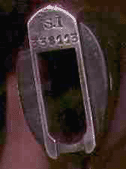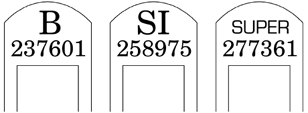Star Firearms
Finding & Interpreting Star Model Numbers
Model names are all too frequently a source of confusion for Star pistols. Especially for the older pistols, there are just a few tips you need to know to almost always find the correct model of your gun.
Older pistols

First of all, there is simply no such thing as a model SA, or S.A. That is part of the company name, and means "Anonymous Society," (Sociedad Anónima). Kind of like Inc. or Corp. in the US. The right place to find all older Star pistol model numbers is on the butt, as seen in the illustrations below and photo to the right. On the flat plate on the bottom of the gun, just rear of where the magazine is inserted, look for a letter, set of letters or a word. The longer number is your serial number, incidentally.

If there is letter code, the first letter is always what I call the series. Any following letters are modifications to (variants of) the base gun. Note that most series also have variants that are not differentiated by a letter code change. I know of only some of the definitions; I and N mean a caliber change from the basic version, S means that they are updated to include a magazine safety and K means an aluminum frame. There are others as well, but some have various meanings, such as D where on the PD it seems to mean "small," and on the MD it means "fully-automatic." Very confusing.
| Series: | Suffix: | ||
|---|---|---|---|
| s | .380 | i | .32 version of a .380 gun |
| si | .32 | n | .380 version of a .32 gun? |
| a | .38 ACP/9 mm Largo | s | magazine or other safety added |
| b | 9 mm Parabellum/Luger | k | alloy frame |
| m | .38 ACP/9 mm Largo | d | selective fire (not always) |
| p | .45 | b | Stocked semi-automatic |
| r | ? | ||
| m | ? | ||
| o | ? | ||
Just to add more trouble, some pistols will simply be marked "Super," with no letter codes. These are the Super (linkless, quick-takedown lever) versions of a number of models. I know of the Super designation appearing alone on model A and B pistols, but it can be on others as well. Use caliber and other details of the gun to determine your model if this is the case.
Some older pistols will have no model number on the butt. This used to be rare, but is increasingly common as old stocks are cleared out. These are all the year coded, Spanish government issue pistols, like the Model 1922 and Model 1940. Some will clearly be these, as they will carry appropriate crests, or military acceptance stamps. Some will simply need to be identified by looking at photos. Check the model A and B pages for the closest match and read the descriptions.
The chart to the right delineates the differences between some of the more confusingly similar pistols, and what I know of some of the suffix codes. Models A and B, for example, are confusingly similar, but are (apparently) differentiated by caliber. Suffix codes are changes to the base gun. Some are not at all clear, but the ones I know are listed here.
Another confusion comes up sometimes in caliber markings being confused with weapon names. Patronen '08 is a way of saying "the cartridges that fit in the model 1908 pistol." The Pistol '08 is the Luger, and more recently the cartridge that fits it is called the 9 mm Luger, or Parabellum. Up thru the 50s at least, a number of Stars in 9 mm had the chamber hoods stamped P'08 or something similar. This is just a caliber notation. The German-issued Star Pistols were only made from 1942-44, should have the last three digits of the serial on all major components, and may have German Army and/or Nazi proofmarks. Identification of this weapons continues to be problematic.
Modern pistols
Newer pistols have a model name or number, sometimes with a type suffix, clearly on the sides of the gun. Any brand names (e.g. "Firestar Plus") are on the slide and any listed model numbers are on the right side of the frame above the grip panels. Some pistols will have no model number listed. The Megastar, for example, is the Model 50, but is [more or less] invariably sold as the "Model Megastar."
All the modern pistols have model numbers instead of letters, starting with 28. I have no idea what happened to the first 27 or to many of the numbers in between. Some are clearly also just chosen for marketing needs, like the .45 ACP caliber Firestar M45. Some also have other apparent meanings. The Firestar Plus is the M243, where adding 200 to the M43 must mean "super version" or something to the Star engineering department. Similarly, the M105 was an alloy predecessor to the M205 plastic framed Ultrastar. Not obvious what they all mean, but they definitely mean something.
Some of the modern pistols also use variant designators. These are much simpler, though. Basically M (Military) means steel, and usually the longer of the two, and P (Police) means shorter. K continues to mean alloy-framed. These are used on the 28/30/31 series, and are always used but not all variants exist.. There is no "base" Model 30, and no M30MK or M30P. Sometimes, these are not used at all, so the model number for the Firestar Plus has no K suffix, to designate that it is alloy framed.
Variants, not descriptors
If trying to interpret your gun, or figure this out generally, my working theory is that suffixes are generally for variants, and not to be universal descriptors. Compare to the S&W number scheme for 3rd generation pistols; each part of the 4 digit code meant the caliber, frame size, frame material, and action. Star pistols appear to be a model then variation. So the M243 is always alloy framed, so no need to have a "K" suffix to say anything about the alloy frame as that's standard.
It is not a perfect theory, such as the M30M vs PK, but I have worked lots of companies that also have a system to name their stuff... sorta. It is likely they simply did some of this wrong, didn't care, or marketing had a good idea.
Once you find the model, you can look up which series it is in and go to the relevant page on the table here.
Importers Marks
I get asked a lot about marks that end up being import marks. Weapons made outside the US must be imported, and stamped with the importer company name and location. I am sure other countries have similar regulations. Import stamps are usually not going to match, many will even be non-straight or will not have been finished over. US importers include Interarms and CAI (I will add others as I recall them). Location can be as little as city and state, or even odd abbreviations; American Arms has always just stamped "NKC" to mean "North Kansas City, Missouri."
The main U.S. importers of new, commercial sale Stars were the Garcia Corp. in Washington, D.C. and Interarms of Alexandria, Virginia. Lately, a few others have started importing used surplus guns, most notably Century Arms; these guns will carry a stamp reading "C.I.A. ST. ALB VI.," often in odd places. Magnum Research has always been an importer, as their primary product line is actually made in Israel. They have, over the years, imported other things as they come up, but usually do not advertise under their own name in any way. These will have the "MRI MNPLS MN" stamping, usually on the bottom of the dust cover.
Especially because of the large number of Star pistols imported as surplus, import marks are almost always of no value when trying to identify the gun. If you are trying to buy one, they can be useful, as many people will post the gun for sale as being made by Interarms, and so on.